Have been debating this with myself, 2 sharp ends are better than 1 in my opinion. Less running to the grinder.Great discussion on bowl gouges! I need a second 5/8 inch gouge. Was thinking of getting a double-ended Oneway Mastercut. I don’t mean to change the subject, but does anyone use these double-ended gouges? Or do you prefer single ended wood-handled tools?
-
December 2025 Turning Challenge: Single Tree! (click here for details) -
Congratulations to Bob Henrickson, People's Choice in the November 2025 Turning Challenge (click here for details) -
Congratulations to Steven Gordon for "Dropped Ice Cream Cone" being selected as Turning of the Week for December 8, 2025 (click here for details) -
Welcome new registering member. Your username must be your real First and Last name (for example: John Doe). "Screen names" and "handles" are not allowed and your registration will be deleted if you don't use your real name. Also, do not use all caps nor all lower case.
You are using an out of date browser. It may not display this or other websites correctly.
You should upgrade or use an alternative browser.
You should upgrade or use an alternative browser.
What size bowl gouges do you have/use
- Thread starter William Rogers
- Start date
Related to this topic, which brands are best for an Ellsworth grind? I've got a 5/8" Crown Ellsworth, and I've applied an Ellsworth grind to my 5/8" and 1/2" D-Ways. I see a lot of love for the Thompson gouges, but is his U shaped appropriate for this grind?
Angelo
President Emeritus
- Joined
- Jun 14, 2004
- Messages
- 430
- Likes
- 182
- Location
- Lancaster, Pennsylvania
- Website
- www.majicbrand.com
Dr. Kapolowitz?I have 11 Thompson 5/8" V bowl gauges. I have no idea how I acquired 11. It does give me the ability to turn for a long time before I have to sharpen. It is my motto - you can never have too many 5/8" gauges.
I see a lot of love for the Thompson gouges, but is his U shaped appropriate for this grind?
No
Kevin Jesequel
TOTW Team
I see a lot of love for the Thompson gouges, but is his U shaped appropriate for this grind?
But the 5/8" parabolic flute gouge that Thompson makes for Lyle Jamieson would be appropriate for the Ellsworth grind. Jamieson's grind is already very similar. I have this gouge and like it a lot.
- Joined
- Apr 27, 2004
- Messages
- 9,304
- Likes
- 6,058
- Location
- Lakeland, Florida
- Website
- www.hockenberywoodturning.com
Related to this topic, which brands are best for an Ellsworth grind? I've got a 5/8" Crown Ellsworth, and I've applied an Ellsworth grind to my 5/8" and 1/2" D-Ways. I see a lot of love for the Thompson gouges, but is his U shaped appropriate for this grind?
The gouge Lyle Jamieson sells is made by Thompson and has a parabolic flute.
This gouge is my favorite tool because the flute is just a little wider than most.
Beginners will appreciate the slightly wider flute
Advance turners will who use the flute up shear cut with the leading edge of the wing will love it.
My second favorite has become the Robust gouge also a parabolic flute.
Hmm, I do have one of the DT gouges that he makes for Lyle, and looking at it, it seems to be the same V shape, but wider than the standard DT V flute. I didn't think it was a true parabolic flute. I know Doug makes a signature gouge for Jimmy Clewes as well, but don't have one of those, at least not yet.... I don't use swept back gouges any more, not since I started using the 40/40. However, I think the parabolic flute is ideally suited for the swept back grind. The V gouges from Doug also work very sell. Main thing to remember when sharpening the V flutes, is that when you roll from the nose to the wing, you roll it over faster than you do when you are sharpening a parabolic flute. If you stay too long on that transition area, you get that birds mouth effect on your gouge.
robo hippy
robo hippy
- Joined
- Apr 27, 2004
- Messages
- 9,304
- Likes
- 6,058
- Location
- Lakeland, Florida
- Website
- www.hockenberywoodturning.com
Hmm, I do have one of the DT gouges that he makes for Lyle, and looking at it, it seems to be the same V shape, but wider than the standard DT V flute.
I have 2
Description from lyle’s web site
FLUTES
This has a better flute configuration—Not a “V”, not a “U” shape—It is 12 inches long with a 7 inch long flute —It has a wider, parabolic flute shape than any other gouge made today—The flute change translates into easier, safer, better control.
couple of screen shots from a demo video that show the flute
Shows the wide round bottom of the flute.
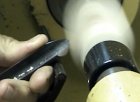

@hockenbery
You cost me money but I am really happy with it so far.
You cost me money but I am really happy with it so far.
Hmm, I do have one of the DT gouges that he makes for Lyle, and looking at it, it seems to be the same V shape, but wider than the standard DT V flute. I didn't think it was a true parabolic flute. I know Doug makes a signature gouge for Jimmy Clewes as well, but don't have one of those, at least not yet.... I don't use swept back gouges any more, not since I started using the 40/40. However, I think the parabolic flute is ideally suited for the swept back grind. The V gouges from Doug also work very sell. Main thing to remember when sharpening the V flutes, is that when you roll from the nose to the wing, you roll it over faster than you do when you are sharpening a parabolic flute. If you stay too long on that transition area, you get that birds mouth effect on your gouge.
robo hippy
As mentioned previously I have a BB, Crown M42 Razor, and DT 5/8” shaft Bowl gouges. Crown makes Ellsworth’s signature tool with parabolic flute, and Crown states all their bowl gouges have the same parabolic flute. Cutting wood, sharpening, or just looking at the 3 tools, there is no discernible difference among the 3 other than steel. They behave the same in a cut.
I have two 5/8"diameter gouges I use the most, a Thompson v ground 40/40 and a Crown Ellsworth signature model. I also have a 1/2" parabolic flute 40/40 which doesn't see much use and a 7/8" u shape gouge ground to about 70 degrees and almost square across for a bottom feeder. The last one seems huge but it works well with little vibration when extended out over the tool rest.
Of the first two I like them for different qualities. The Ellsworth is more versatile, better for pull cuts and getting into the transition area on moderately deep bowls, also shear scraping due to the convex wings. The v profile seems better suited to a push cut and more efficient at hogging, plus needs sharpening less often than the M2. I use it more for roughing and for exterior finishing when possible.
Of the first two I like them for different qualities. The Ellsworth is more versatile, better for pull cuts and getting into the transition area on moderately deep bowls, also shear scraping due to the convex wings. The v profile seems better suited to a push cut and more efficient at hogging, plus needs sharpening less often than the M2. I use it more for roughing and for exterior finishing when possible.
Five bowl gouges, and the realization that I wasted a bunch of money that could have been used to help someone......on the other 5 bowl gouges that is. I'll be gone and someone will be buying my stuff for pennies on the dollar. Now, where is that darn catalog I ordered?!
You should be able to flip your lathe over rather than stalling it with a 3HP. Something is not right, maybe the belt is slipping.Years ago, one of the "old salt mentors" I had asked a group of us turners he was instructing..."what is the first 2 lathe tools everyone should buy?" The group sort of settled on a 5/8" gouge and a 1" skew as a response. Jokingly he said, "Don't be silly. You go buy two 5/8s and don't ever own a skew unless someone just gives you one."
Back to the 3/4 gouge issue. I can stall my 3 hp lathe pretty readily with a 5/8...so I'm not sure that a 3/4 adds anything to the business of cutting.
The belt is not slipping and the lathe is working like a champ...but I can put a big old hunk of wet wood on there and stall it when the conditions are right.You should be able to flip your lathe over rather than stalling it with a 3HP. Something is not right, maybe the belt is slipping.
Emiliano, like Bill Grumbine commented once, 'I can stall a VB36'. I haven't met a lathe I can't stall. I believe there is built in 'slippage' so people don't get launched into orbit. Maybe if I had a 10 hp lathe and proper gearing, that could change. I can stall my AB and my Vic with my 1 inch Big Ugly tools, and with my 5/8 gouges, if I want to...
robo hippy
robo hippy
You guys need to try a Stubby.Emiliano, like Bill Grumbine commented once, 'I can stall a VB36'. I haven't met a lathe I can't stall. I believe there is built in 'slippage' so people don't get launched into orbit. Maybe if I had a 10 hp lathe and proper gearing, that could change. I can stall my AB and my Vic with my 1 inch Big Ugly tools, and with my 5/8 gouges, if I want to...
robo hippy
@john lucas Are you looking to get rid of your 3/4" gouge?I was given a 3/4" bowl.gouge. I did not like it. It was heavy and didnt take any bigger cut than my 5/8". I use a 1/2" 90 percent of the time.
Emeliano, I am going to have to migrate over there for a play date some time, and bring my Big Ugly tool.... Probably have to wait till I can get vaccinated. My girlfriend is an ER nurse and just got her second shot...
robo hippy
robo hippy
Interesting conversation, clearly it seems that the 5/8 is the gouge of choice. That said, I only have a pair of 1/2's and am strongly considering getting a 5/8 as the next one. Anyone ever go back to a smaller one after having a 5/8"? Seems the additional mass as well as length of cutting surfaces would be helpful.
Does lathe power play into this decision as well? Mine is only 3/4"HP with VFD and Reeves Drive
Does lathe power play into this decision as well? Mine is only 3/4"HP with VFD and Reeves Drive
Kirk - I think you’ll be happier sticking with 1/2” on a 3/4hp reeves drive. I use both 5/8 and 1/2 (and others) on my PM3520. But I also have a Comet2 (3/4hp) and almost never use the 5/8 with that lathe, it just doesn’t have enough power to take big bites with a 1/2 yet alone a 5/8. Bar diameters.
Now I use my Thompson 5/8 V on any of the lathes in my shop whether it is 3/4 HP, 2 HP or anything in between. It's the gouge I'm most comfortable with but that doesn't mean that I won't use a Thompson 1/2 or 3/8 V when I need to. Everything in woodturning could or should be based on how you feel about it. Just because I like Thompson tools doesn't mean anyone else does. Nor what I have is not to be construed by you as the best it is what I believe is the best for me. You want to find out if you want a 5/8" tool find someone who has one and try it, but remember their grind may not suit you (oh but life is a complicated thing ).
).
Technically speaking Gouge dia needed is a function of bending loads created by edge load and distance between the cutting edge and tool rest. Harmonic vibration can play into it as well - a slightly lighter or heavier tool and the change in cut geometry can remove the vibration.
While a 3/4hp lathe can easily be overpowered by a 5/8” gouge, the heavier tool may feel better doing interrupted cuts. Its an individual choice. I agree that “road testing” one could tell you a lot. I use a 5/8” 95% of the time. I use a 3/8” the other 4.9%, and use a 1/2” the other 0.1% which is when I remember I have one. Doesnt mean a 1/2” isnt just as good most of the time, especially with 3/4hp.
While a 3/4hp lathe can easily be overpowered by a 5/8” gouge, the heavier tool may feel better doing interrupted cuts. Its an individual choice. I agree that “road testing” one could tell you a lot. I use a 5/8” 95% of the time. I use a 3/8” the other 4.9%, and use a 1/2” the other 0.1% which is when I remember I have one. Doesnt mean a 1/2” isnt just as good most of the time, especially with 3/4hp.
Doug - that is what I was thinking - that the extra mass may help smooth some vibration out, particularly at a point where there is 3+ inches of tool over the rest, as comes up when hollowing a bowl. Comparing using a #3 hand plane with a 4 or 4 1/2, the larger one sometimes is easier.
I tend to use my 5/8 gouge more when turning a wet blank. It takes larger cuts, up to 1/2 inch wide shavings. The 1/2 and 3/8 inch gouges get used more for dry wood turning and finishing cuts. I’ve been tempted to try a 3/4 inch gouge for rough wet turning, but not sure it would be that much faster than a 5/8. I guess I’m not in that much of a hurry.
I ordered one of these today from Lyle's website - and noticed the Thompson 5/8" V gouges are out of stock. I plan on doing an Ellsworth grind for it, at least until someone teaches me the 40/40. I had been wanting to try a parabolic style flute and this is my first 5/8 gouge (I have two 1/2"s).But the 5/8" parabolic flute gouge that Thompson makes for Lyle Jamieson would be appropriate for the Ellsworth grind. Jamieson's grind is already very similar. I have this gouge and like it a lot.
Am I correct in thinking I'll need to order the Ellsworth grinding jig to use with the Wolverine system (and CBN wheels)? Any considerations?
Dave Landers
Beta Tester
Allen, I use the varigrind to get an Ellsworth grind. Well, it was an Ellsworth originally, I think I use longer wings now. Anyway, a couple years ago, I bought an Ellsworth signature gouge and messed with my varigrind till it matched.
My setup is with the varigrind as shown (picture avoids having to name or number the notches). My offset is 1-15/16" (no reason, it just is what it is, and I just measured it). And if I measure from center of the axle of my 8" CBN wheel to the tip of the v-arm where the varigrind fits, that's pretty close to 11-1/2"
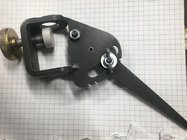
My setup is with the varigrind as shown (picture avoids having to name or number the notches). My offset is 1-15/16" (no reason, it just is what it is, and I just measured it). And if I measure from center of the axle of my 8" CBN wheel to the tip of the v-arm where the varigrind fits, that's pretty close to 11-1/2"

- Joined
- Apr 27, 2004
- Messages
- 9,304
- Likes
- 6,058
- Location
- Lakeland, Florida
- Website
- www.hockenberywoodturning.com
Am I correct in thinking I'll need to order the Ellsworth grinding jig to use with the Wolverine system (and CBN wheels)? Any considerations?
you can get close with the woulverine.
i Use the Ellsworth jig. Wolverine pocket is too low to use with the Ellsworth jig.
I made a riser block I carry with me.
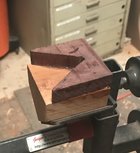
What is the thickness/height of the riser block if I make one for use w/ the Ellsworth jig? Thanksyou can get close with the woulverine.
i Use the Ellsworth jig. Wolverine pocket is too low to use with the Ellsworth jig.
I made a riser block I carry with me.View attachment 38327
I think, if you want The Ellsworth Grind, you probably would need the Ellsworth jig, but you can get pretty close, as others have said, with the wolverine.
My sharpening style has changed over the years and I've sort of settled into the shape you see here. The initial setup with the Ellsworth jig uses the following dimensions of 7 inches from the face of the wheel and 4 inches down from center. Here are some pics... So adding a block to the V pocket would be what ever was needed to bring it to 4 inches.
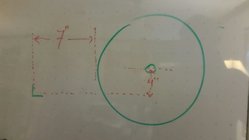
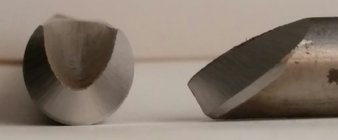
My sharpening style has changed over the years and I've sort of settled into the shape you see here. The initial setup with the Ellsworth jig uses the following dimensions of 7 inches from the face of the wheel and 4 inches down from center. Here are some pics... So adding a block to the V pocket would be what ever was needed to bring it to 4 inches.


- Joined
- Apr 27, 2004
- Messages
- 9,304
- Likes
- 6,058
- Location
- Lakeland, Florida
- Website
- www.hockenberywoodturning.com
What is the thickness/height of the riser block if I make one for use w/ the Ellsworth jig? Thanks
as @Clifton C said. The pivot point for the Ellsworth jig us out 7” from the face of the wheel an 4” down from the center of the wheel. You can make a fixture using 3/4” square tubing.
I made one with U bolts and wood.
saw a nice one made drilling a vertical hole through the 3/4” tubing for a bolt or all thread.
2 nuts to hold it in place and adjust the height.
a 3/16 deep hole drilled in the top makes the pivot point.
for an 8” wheel the height is at the bottom of the wheel.
For those of you with multiple bowl gouges in the same size, how do you track how they are each set up? Do you mark them somehow, or do you just simply turn enough to remember how each is set up?
When you guys measure your gouges, are you using shaft diameter, or distance across the flute?
-----odie-----
I have no idea what I'm talkin' 'bout, but this morning I stumbled across this statement on http://www.onewayeuropa.com/tools/mastercut.htm :
"British and North American nomenclature for tool sizes differs. When a British toll manufacturer says the size is 3/8" - the 3/8 refers to the distance across the flute. Whereas a North American 3/8" tool size refers to the outside of the tool!"
Clear as mud, now?
Odie
Panning for Montana gold, with Betsy, the mule!
I have no idea what I'm talkin' 'bout, but this morning I stumbled across this statement on http://www.onewayeuropa.com/tools/mastercut.htm :
"British and North American nomenclature for tool sizes differs. When a British toll manufacturer says the size is 3/8" - the 3/8 refers to the distance across the flute. Whereas a North American 3/8" tool size refers to the outside of the tool!"
Clear as mud, now?
Yeah.....that's why I had to ask. It's confusing because the measurement isn't standardized across the industry. I've actually bought gouges of the wrong size, because of that! :mad:
-----odie-----
Based on recommendations (above) I ordered the ⅝" Jamieson/Thompson; it arrived yesterday. I haven't turned with it yet, but the first thing I did was to figure out the recipe for the edge that it came with. 2" extension, 4 ⅞" extension of the V arm (i.e. a 4 ⅞" piece of pvc will fit), and the bottom of the arm in the middle of the second notch (i.e. 1 ½ notches from the bottom).
(We really need a standardized nomenclature for all of this.)
(We really need a standardized nomenclature for all of this.)
@odie: Well, there *was* one standard (the British one) before gouges made from round stock came around.
That said, I prefer (and use) the US/international one. It will take a while before UK turners and tool makers accept and adopt a "foreign" standard since every mentor teaching a new turner will be using (=teaching) the old standard and would frown on Sheffield makers adopting a non-British standard.
That said, I prefer (and use) the US/international one. It will take a while before UK turners and tool makers accept and adopt a "foreign" standard since every mentor teaching a new turner will be using (=teaching) the old standard and would frown on Sheffield makers adopting a non-British standard.
I mark them 2 different ways - Tool ID and Grind ID. I store all my tools handle up, with the steel in a pvc tube. Most all tools have a Tool ID, a 3/4" round adhesive sticker on the end of the handle, printed with my own abbreviations to ID the tool, and different tool types have a different background color:For those of you with multiple bowl gouges in the same size, how do you track how they are each set up? Do you mark them somehow, or do you just simply turn enough to remember how each is set up?

Grind ID - Bowl and spindle gouges (and a few others) get an adhesive label stuck to the ferrule, and that label is covered with "Super Hold" scotch tape.. I use a Tormek gouge jig, so the info on the label is different, but the same type of info could be used for any sharpening system:
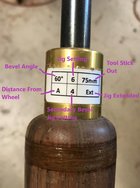
Doug, that is too complicated for me. I use the blue painter's tape and write the platform setting on it..... Plus, I could never figure out how to print all that stuff out onto any type of paper or decal....
Maybe for gouge definitions, we should switch to shaft size rather than having 2 different names....
robo hippy
Maybe for gouge definitions, we should switch to shaft size rather than having 2 different names....
robo hippy
I understand, painter’s tape works too! All my years of 5S and continuous improvement in the mfg world makes it very easy for me. While I do have a Crown 1/2” BG, it is labeled 5/8”, the shaft size. The world may not standardize but we can!Doug, that is too complicated for me. I use the blue painter's tape and write the platform setting on it..... Plus, I could never figure out how to print all that stuff out onto any type of paper or decal....
Maybe for gouge definitions, we should switch to shaft size rather than having 2 different names....
robo hippy
Love this!Based on recommendations (above) I ordered the ⅝" Jamieson/Thompson; it arrived yesterday. I haven't turned with it yet, but the first thing I did was to figure out the recipe for the edge that it came with. 2" extension, 4 ⅞" extension of the V arm (i.e. a 4 ⅞" piece of pvc will fit), and the bottom of the arm in the middle of the second notch (i.e. 1 ½ notches from the bottom).
(We really need a standardized nomenclature for all of this.)
-----
I'm fairly new to this sport, but I've found going by shaft size makes the most sense to me (I'm in the US) and seems to have less variables. If I can't know the shaft size I'm probably not buying the tool. I suppose that could change. Part of that is I might want things to fit removable handles. Part of that is I've read a few of Odie's posts
I misunderstood at first. This setup can be use in place of the Ellsworth jig or with it, dependingas @Clifton C said. The pivot point for the Ellsworth jig us out 7” from the face of the wheel an 4” down from the center of the wheel. You can make a fixture using 3/4” square tubing.
I made one with U bolts and wood.
saw a nice one made drilling a vertical hole through the 3/4” tubing for a bolt or all thread.
2 nuts to hold it in place and adjust the height.
a 3/16 deep hole drilled in the top makes the pivot point.
for an 8” wheel the height is at the bottom of the wheel.
Excellent, thanks for sharing this.I think, if you want The Ellsworth Grind, you probably would need the Ellsworth jig, but you can get pretty close, as others have said, with the wolverine.
My sharpening style has changed over the years and I've sort of settled into the shape you see here. The initial setup with the Ellsworth jig uses the following dimensions of 7 inches from the face of the wheel and 4 inches down from center. Here are some pics... So adding a block to the V pocket would be what ever was needed to bring it to 4 inches.
View attachment 38331 View attachment 38332
